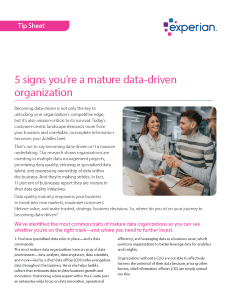- Products

Enjoy a free 30-day trial of our
data validation software.Experience the power of trusted data
solutions today, no credit card required! - Solutions

Enjoy a free 30-day trial of our
data validation software.Experience the power of trusted data
solutions today, no credit card required! - Partners

Enjoy a free 30-day trial of our
data validation software.Experience the power of trusted data
solutions today, no credit card required! - Learn more
- Pricing
- Contact Us
5 signs you're a mature data-driven organization
Becoming data-driven is not only the key to unlocking your organization’s competitive edge, but it’s also mission-critical to its survival. Today’s customer-centric landscape demands more from your business and unreliable, incomplete information becomes your Achilles heel.
That’s not to say becoming data-driven isn’t a massive undertaking. Our research shows organizations are investing in multiple data management projects, prioritizing data quality, enlisting in specialized data talent, and reassessing ownership of data within the business. And they’re making strides. In fact, 11 percent of businesses report they are mature in their data quality initiatives.
Data quality maturity empowers your business to break into new markets, maximize customers’ lifetime value, and make trusted, strategic business decisions. So, where do you sit on your journey to becoming data-driven?
We’ve identified the most common traits of mature data organizations so you can see whether you’re on the right track—and where you need to further invest.
1. You have specialized data roles in place—and a data commander
The most mature data organizations have an array of data practitioners—data analysts, data engineers, data scientists, and more—led by a chief data officer (CDO) who evangelizes data throughout the business. He or she helps build a culture that embraces data to drive business growth and innovation. Positioning a data expert within the C-suite puts an enterprise-wide focus on data innovation, operational efficiency, and leveraging data as a business asset, which positions organizations to better leverage data for analytics and insights.
Organizations without a CDO are not able to effectively harness the potential of their data because, among other factors, chief information officers (CIO) are simply spread too thin.
2. Your organization is focused on enabling wider data usage
Your organization realizes it cannot achieve its data-driven objectives unless individuals in the business have the trusted data and tools they need to analyze information and make strategic decisions. Therefore, you’re focused on standardizing data across departments and empowering business users with the ability to understand and harness the power of data and analytics, also known as data enablement.
Rather than feuding with IT for data ownership, you and fellow business users view data as a shared responsibility and a business asset. Data is no longer just something relegated to IT—it moves throughout the business, affecting every employee and customer.
3. You’ve invested in multiple data management projects
Organizations with the goal of becoming data-driven on the horizon are often invested in multiple data management initiatives—data quality, big data analytics, machine learning, and more—to gain more insight from enterprise data. If this sounds familiar, then it’s likely you also have a data governance initiative underway to better understand how data is used, to comply with regulations, and to improve the quality of decision-making. You may even be part of the 41 percent of companies that are looking to monetize data with the use of data governance. If machine learning is on the docket, then you’re getting closer to leveraging this technology to improve operational efficiency and financial forecasting.
4. You see data management as a continuous set of processes
You get it: Data management cannot and should not operate within siloed pockets across the business. Siloed data continues to snowball, and inaccurate, duplicate, and incomplete data infiltrates the business. Fixing bad data requires a more holistic approach, and you’re part of the 29 percent of companies looking at data management as an ongoing business initiative that ties to specific outcomes.
By cleaning your data on an ongoing basis, you’re preventing bad information from entering into your system. This ultimately leads to revenue generation, all while driving a better customer experience through accurate data.
5. You’ve invested in data quality
You understand that bad data drags down the business. You’ve identified data quality as a foundational discipline and an area for investment, and better yet, you’re seeing positive data outcomes. You’ve either dedicated time and resources to a manual data cleanup or are working with a data quality management platform to profile and resolve data issues. With trusted data, you’re able to confidently move forward with your data projects and shift time spent from data preparation to data analytics. You’re on your way to becoming a fully mature and optimized data organization!
